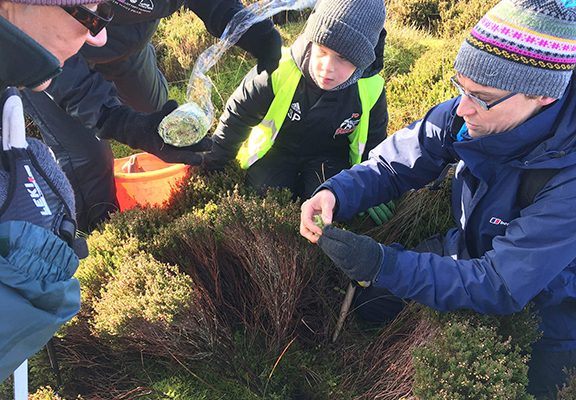- Home
- News
- What’s On
- Activities for Children
- Arts & Crafts
- Autos and Bikes
- Business events
- Car Boot & Auctions
- Charity events
- Churches & Religious
- Comedy
- Dance
- Days out & Local interest
- Education
- Exhibition
- Film
- Gardening & Horticulture
- Health
- Markets & Fairs
- Music
- Nature & Environment
- Spiritual
- Sport
- Talks and Discussions
- Theatre and Drama
- Business
- Local Information
- Jobs
- Deaths
- Charity events
- Contact Us
Volunteers brave the elements to plant sphagnum moss

Above: Staff and volunteers get a tutorial in plug planting from Partnership manager Karen Shelley-Jones.
A major planting project in the Staffordshire Moorlands will help to improve water quality and create more species-rich moors.
Staff and volunteers from the South West Peak Landscape Partnership took part in a week-long sphagnum moss planting project.
Braving wet and windy weather, the team successfully planted 10,000 plug plants, paving the way for further work next year as part of the Partnership’s Upstream Thinking project.
Upstream Thinking is the result of funding awarded to the South West Peak Landscape Partnership by The European Agricultural Fund for Rural Development and will complement funding from The National Lottery Heritage Fund.
The project draws on the experience of farmers and local landowners to improve water quality by increasing understanding, capital investment and natural flood management in the South West Peak. By supporting sustainable upstream land management, far-reaching water quality improvements can be achieved.
Upstream Thinking will also include a range of work, such as producing farm water and soil plans to help reduce agricultural pollution, removing non-native invasive species and creating new habitats. It will restore habitats such as wet heath and blanket bog, which retain a large amount of water and act as natural filters to slow the flow of water into local rivers, filtering out impurities.
Sphagnum moss is the building block for a healthy blanket bog, which stores water and carbon – but it sometimes needs a helping hand to get established. The volunteer work involved carrying rolls of sphagnum plug plants onto the moor, using wooden dibbers to make small holes in the peat, planting the plugs and ensuring they were firmly embedded.
Partnership manager Karen Shelley-Jones said: “In order to compare establishment and growth, sphagnum plugs were planted in areas where heather had been cut by our colleagues from the Moors for the Future Partnership, and in places where the heather was naturally ageing and opening up. By taking before and after photographs and making GPS reference points, we will be able to measure sphagnum growth and get a sense of how well this has worked.
“The whole week of work was organised in shifts, with volunteers and staff in the field nearly all day, every day. This required a lot of endurance and dedication from our volunteers and was met with their usual upbeat attitude! Despite the hard work, our volunteers told us how much they enjoyed working as a team and making a valuable contribution to the environment.”

You must be logged in to post a comment Login